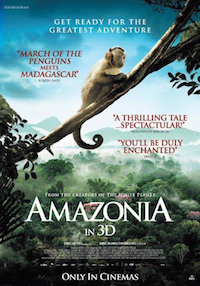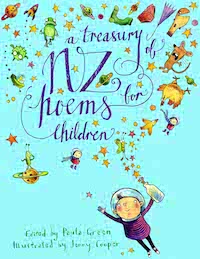
Amazonia
“Cute” was the verdict of our 3 granddaughters ( aged 8, 11 and 13). Togged out in 3D glasses we’d watched a preview of Amazonia which follows the adventures of Sai, a capuchin monkey who was born and raised in captivity .
At the start of the movie a little girl bids Sai a tearful farewell. Tucked up in a cage with a soft toy for company he is put on a plane which takes off for an unknown destination. But misfortune strikes and the plane is forced to crash land in the Amazon jungle. The pilot is seen walking away from the plane. He has abandoned Sai who must now learn to fend for himself in the dense rainforest where danger lurks behind every corner.
Sai’s survival skills are tested to the limit as he encounters all kinds of wild animals: crocodiles, giant otters, jaguars, boas, tapirs, alligators and a gargantuan anaconda.
Towards the end of the movie he happens upon a clearing where destructive logging and burning of the rainforest is going on. Another little girl tries to entice him to be her pet. But by now he longer craves their company and relishes his freedom. He has gained enough confidence in his own survival skills to return to the wild where a family of capuchin monkeys could become his new family.
A movie in which small monkey must face up to so many dangerous animals could have been very frightening, but the potential for violence is kept down and the tension flares up only briefly at each encounter. The movie moves at a surprisingly gentle pace. What holds it together is the stunning views of the rainforest creatures, fauna and foliage which are shown to their very best advantage through the use of 3D.
It took over two years to capture the footage for this movie. Technically it is very clever. The staged encounters between the actual jungle creatures and the Capuchin monkey are made to seem very real.
The underlying message is an environmental one: that the beauty of the rainforest and all that lives and grows there is worth preserving. But it is also a lesson in survival on how to adapt to a hostile environment.
We enjoyed it and think it a good family movie although very young children may find it a little too long. Primary school children would enjoy the story of Sai while we were fascinated by the stunning rainforest photography.
Amazonia. Directed by Thierry Ragobert, Run time 83 minutes, In theatres from Dec 18. (both in 2D and 3D)

A Treasury of New Zealand Poems for Children
Many of the nursery rhymes and poems we learnt as a child, or read to our own children had old colonial roots. Polly first put the Kettle on in 1803 in England. Jack and Hill went up the hill in 1765, and the old woman made her home in a shoe in 1794. So it is timely to have this large collection of New Zealand poems that looks at the world from our point of view and expresses who we are.
Mary Mary Quite Contrary has been replaced by Mary Mary from Jackson’s Dairy. Her garden is filled with kowhai bells and paua shells. Instead of an itsy bitsy spider a teeny-weeny weta climbs up shiny flax and has to do it all over again after the rain comes out and washes him down.
Lauris Edmond writes a poem about the old survivor, tuatara, reptilian great-grandfather and Fiona Farrell has a cautionary poem about a little kiwifruit who peeled off his jacket and got nastily sunburnt.
Many of the poems in this book are by famous New Zealand poets. You will find Margaret Mahy’s poem about George and his pet gorilla and James K Baxter’s poem about a growly bear that lives in a cupboard under the stairs. Other famous names include Joy Cowley, Patricia Grace, Denis Glover, Hone Tuwhare and Janet Frame. You may well have read some of these poems in your younger years as some first appeared in the School Journal (which is sadly no more).
There are also many new voices including winners in a national children’s poetry competition. Nearly two thousand poems from Cape Reinga to Bluff were entered by aspiring young poets and some of the best can be found here..
How do our poets view old age?
With sentimentality and nostalgia: Nadia Moon compares the swirls of pink in a paua shell to her Nanny’s rosy cheeks, and the rough side to her koro’s big hands Louise Tomlinson looks back fondly to holidays spent eating the seafood her nanny cooked for her .John Parker remembers how his granddad picked an apple for him from an old apple tree in his backyard with shaking fingers. Only Margaret Mahy‘s poem “When I am old and wrinkled like a raisin,” is defiantly witty.
Who would like this book?
It’s not just for girls. Boys will also enjoy the quirky humour and poems about a snorting hippopotamus, an armoured armadillo and a sushi eating dragon.
And preschoolers too will enjoy having some of these poems read to them by parents or grandparents, and love the comicky illustrations.
A Treasury of NZ Poems for Children. Author: Paula Green. Publisher:Random House. RRP $37.95









Join the Discussion
Type out your comment here:
You must be logged in to post a comment.